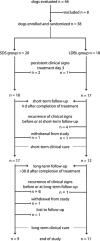Short- and long-term cure rates of short-duration trimethoprim-sulfamethoxazole treatment in female dogs with uncomplicated bacterial cystitis
- PMID: 24673608
- PMCID: PMC4895459
- DOI: 10.1111/jvim.12324
Short- and long-term cure rates of short-duration trimethoprim-sulfamethoxazole treatment in female dogs with uncomplicated bacterial cystitis
Abstract
Background: Long-duration beta-lactam antibiotics are used for empirical treatment in female dogs with uncomplicated bacterial cystitis. However, women with bacterial cystitis are treated with short-duration potentiated sulfonamides because longer courses of beta-lactams result in lower cure and higher recurrence rates.
Hypothesis/objectives: Short-duration potentiated sulfonamide treatment is more efficacious than long-duration beta-lactam treatment in achieving clinical and microbiological cures in female dogs with uncomplicated bacterial cystitis.
Animals: Thirty-eight client-owned female dogs.
Methods: Randomized, double-blinded, placebo-controlled clinical trial. Dogs were treated with TMP-SMX (15 mg/kg PO q12h for 3 days followed by a placebo capsule PO q12h for 7 days; Group SDS; n = 20) or cephalexin (20 mg/kg PO q12h for 10 days; Group LDBL; n = 18). Dogs were monitored for clinical and microbiological cure during treatment and at short- and long-term follow-up.
Results: No statistically significant differences were found between treatment groups in clinical cure rates after 3 days of treatment (89% SDS, 94% LDBL; P = 1.00) and 4 days (85% SDS, 72% LDBL; P = .44) or >30 days (50% SDS, 65% LDBL; P = .50) after conclusion of treatment or in microbiological cure rates 4 days (59% SDS, 36% LDBL; P = .44) or >30 days (44% SDS, 20% LDBL; P = .40) after conclusion of treatment.
Conclusions and clinical importance: We did not identify a difference in cure rates between short-duration sulfonamide and long-duration beta-lactam treatments in female dogs with uncomplicated cystitis. Long-term cure rates in both treatment groups were low. In some female dogs, "uncomplicated" bacterial cystitis may be more complicated than previously recognized.
Keywords: Beta-lactam; Cephalexin; Lower urinary tract infection; Sulfonamide.
Copyright © 2014 by the American College of Veterinary Internal Medicine.
Figures


Similar articles
-
Short-course nitrofurantoin for the treatment of acute uncomplicated cystitis in women.Arch Intern Med. 2007 Nov 12;167(20):2207-12. doi: 10.1001/archinte.167.20.2207. Arch Intern Med. 2007. PMID: 17998493 Clinical Trial.
-
The association of antimicrobial resistance with cure and quality of life among women with acute uncomplicated cystitis.Infection. 2011 Dec;39(6):507-14. doi: 10.1007/s15010-011-0163-z. Epub 2011 Jul 26. Infection. 2011. PMID: 21789523
-
Increasing antimicrobial resistance and the management of uncomplicated community-acquired urinary tract infections.Ann Intern Med. 2001 Jul 3;135(1):41-50. doi: 10.7326/0003-4819-135-1-200107030-00012. Ann Intern Med. 2001. PMID: 11434731 Review.
-
Comparison of ciprofloxacin (7 days) and trimethoprim-sulfamethoxazole (14 days) for acute uncomplicated pyelonephritis pyelonephritis in women: a randomized trial.JAMA. 2000 Mar 22-29;283(12):1583-90. doi: 10.1001/jama.283.12.1583. JAMA. 2000. PMID: 10735395 Clinical Trial.
-
Practice guidelines for the treatment of uncomplicated cystitis.Curr Urol Rep. 2001 Aug;2(4):326-9. doi: 10.1007/s11934-001-0072-2. Curr Urol Rep. 2001. PMID: 12084260 Review.
Cited by
-
Prevalence and Antimicrobial Resistance of Bacterial Uropathogens Isolated from Dogs and Cats.Antibiotics (Basel). 2022 Dec 1;11(12):1730. doi: 10.3390/antibiotics11121730. Antibiotics (Basel). 2022. PMID: 36551391 Free PMC article.
-
A double-blinded randomized placebo-controlled non-inferiority trial protocol for postoperative infections associated with canine pyometra.BMC Vet Res. 2023 Jun 20;19(1):77. doi: 10.1186/s12917-023-03629-w. BMC Vet Res. 2023. PMID: 37340459 Free PMC article.
-
Urinary tract infection and subclinical bacteriuria in cats: A clinical update.J Feline Med Surg. 2019 Nov;21(11):1023-1038. doi: 10.1177/1098612X19880435. Epub 2019 Oct 10. J Feline Med Surg. 2019. PMID: 31601143 Free PMC article. Review.
-
Short versus longer duration antibiotic treatment for urinary tract infections in companion animals: a systematic review and meta-analysis.BMC Vet Res. 2025 Apr 17;21(1):280. doi: 10.1186/s12917-025-04722-y. BMC Vet Res. 2025. PMID: 40241166 Free PMC article.
-
Staphylococcal skin infection isolates from dogs without recent antibiotic exposure are 100% susceptible to clindamycin.Front Vet Sci. 2025 Feb 10;11:1512582. doi: 10.3389/fvets.2024.1512582. eCollection 2024. Front Vet Sci. 2025. PMID: 39996263 Free PMC article.
References
-
- Chew DJ. Diagnosing Initial and Recurrent Urinary Tract Infections in Dogs. Orlando, FL: North American Veterinary Conference; 2001.
-
- Drekonja DM, Johnson JR. Urinary tract infections. Prim Care 2008;35:345–367. - PubMed
-
- Fang LS, Tolkoff‐Rubin NE, Rubin RH. Efficacy of single‐dose and conventional amoxicillin therapy in urinary‐tract infection localized by the antibody‐coated bacteria technique. N Engl J Med 1978;298:413–416. - PubMed
-
- Nicolle LE. Urinary tract infection: Traditional pharmacologic therapies. Dis Mon 2003;49:111–128. - PubMed
-
- Moura A, Nicolau A, Hooton T, et al. Antibiotherapy and pathogenesis of uncomplicated UTI: Difficult relationships. J Appl Microbiol 2009;106:1779–1791. - PubMed
Publication types
MeSH terms
Substances
LinkOut - more resources
Full Text Sources
Other Literature Sources

